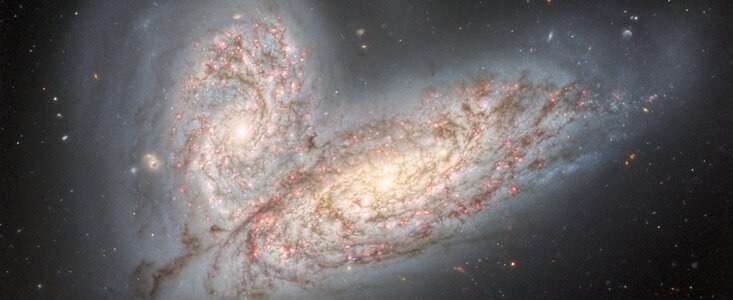One of the twin telescopes of the International Gemini Observatory, Gemini North, which is run by the NOIRLab of the NSF, has discovered the first signs of a cosmic collision that is taking place around 60 million light-years away in the direction of the constellation Virgo.
 An evocative new image captured by the Gemini North telescope in Hawai‘i reveals a pair of interacting spiral galaxies—NGC 4568 and NGC 4567—as they begin to clash and merge. These galaxies are entangled by their mutual gravitational field and will eventually combine to form a single elliptical galaxy in around 500 million years. Also visible in the image is the glowing remains of a supernova that was detected in 2020. Image Credit: Noir Lab.
An evocative new image captured by the Gemini North telescope in Hawai‘i reveals a pair of interacting spiral galaxies—NGC 4568 and NGC 4567—as they begin to clash and merge. These galaxies are entangled by their mutual gravitational field and will eventually combine to form a single elliptical galaxy in around 500 million years. Also visible in the image is the glowing remains of a supernova that was detected in 2020. Image Credit: Noir Lab.
A galaxy merger, one of the most stunning phenomena in the universe, is about to occur between the two imposing spiral galaxies — NGC 4568 and NGC 4567.
The distance between the centers of these galaxies is currently 20,000 light-years or approximately the distance from Earth to the core of the Milky Way, and each galaxy still resembles a pinwheel. But things will not stay this way forever.
Dueling gravitational forces between NGC 4568 and NGC 4567 will cause the two galaxies to coalesce and come closer to one another, resulting in wildly distorted structures and strong bursts of stellar formation.
A single spherical galaxy will emerge from the turmoil after millions of years of the galaxies continuously swinging by one another in ever-tightening loops, dragging out protracted streamers of stars and gas. By then, most of the gas and dust in this system, which serve as the fuel for star formation, will have either run out or been blasted away.
The Milky Way and its nearest massive galactic neighbor, the Andromeda Galaxy, will collide in about 5 billion years, and this merger provides a glimpse of what will happen when that occurs.
The fading afterglow of a supernova, known as SN 2020fqv, that was discovered in 2020, is seen as a luminous area in the middle of one of NGC 4568’s sweeping spiral arms. Data collected in 2020 was used to create the latest Gemini image.
Astronomers now have convincing evidence that merging spiral galaxies like these move on to become elliptical galaxies due to a number of decades of observations and computer models.
NGC 4568 and NGC 4567 are expected to ultimately resemble Messier 89, an elliptical galaxy also located in the Virgo Cluster, which is its more developed companion. Messier 89 no longer shows significant star formation due to its lack of star-forming gas and is mostly composed of old, low-mass stars and globular clusters.
Astronomers were able to acquire this stunning image thanks to the Gemini Multi-Object Spectrograph North (GMOS-N) on the Gemini North telescope and the dry air atop Maunakea’s summit.
The image was acquired through the NOIRLab Legacy Imaging Program by the team responsible for communication, education, and engagement.